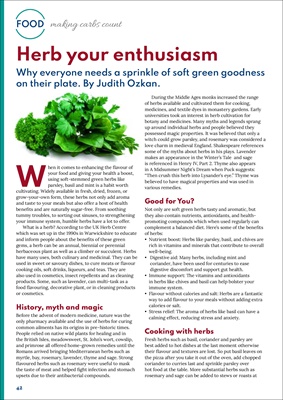
42
FOOD making carbs count
Herb your enthusiasm
Why everyone needs a sprinkle of soft green goodness
on their plate. By Judith Ozkan.
When it comes to enhancing the flavour of
your food and giving your health a boost,
using soft-stemmed green herbs like
parsley, basil and mint is a habit worth
cultivating. Widely available in fresh, dried, frozen, or
grow-your-own form, these herbs not only add aroma
and taste to your meals but also offer a host of health
benefits and are naturally sugar-free. From soothing
tummy troubles, to sorting out sinuses, to strengthening
your immune system, humble herbs have a lot to offer.
What is a herb? According to the UK Herb Centre
which was set up in the 1990s in Warwickshire to educate
and inform people about the benefits of these green
gems, a herb can be an annual, biennial or perennial
herbaceous plant as well as a climber or succulent. Herbs
have many uses, both culinary and medicinal. They can be
used in sweet or savoury dishes, to cure meats or flavour
cooking oils, soft drinks, liqueurs, and teas. They are
also used in cosmetics, insect repellents and as cleaning
products. Some, such as lavender, can multi-task as a
food flavouring, decorative plant, or in cleaning products
or cosmetics.
History, myth and magic
Before the advent of modern medicine, nature was the
only pharmacy available and the use of herbs for curing
common ailments has its origins in pre-historic times.
People relied on native wild plants for healing and in
the British Isles, meadowsweet, St. John's wort, cowslip,
and primrose all offered home-grown remedies until the
Romans arrived bringing Mediterranean herbs such as
myrtle, bay, rosemary, lavender, thyme and sage. Strong
flavoured herbs such as rosemary were useful to mask
the taste of meat and helped fight infection and stomach
upsets due to their antibacterial compounds.
During the Middle Ages monks increased the range
of herbs available and cultivated them for cooking,
medicines, and textile dyes in monastery gardens. Early
universities took an interest in herb cultivation for
botany and medicines. Many myths and legends sprang
up around individual herbs and people believed they
possessed magic properties. It was believed that only a
witch could grow parsley, and rosemary was considered a
love charm in medieval England. Shakespeare references
some of the myths about herbs in his plays. Lavender
makes an appearance in the Winter's Tale and sage
is referenced in Henry IV, Part 2. Thyme also appears
in A Midsummer Night's Dream when Puck suggests:
"Then crush this herb into Lysander's eye." Thyme was
believed to have magical properties and was used in
various remedies.
Good for You?
Not only are soft green herbs tasty and aromatic, but
they also contain nutrients, antioxidants, and healthpromoting
compounds which when used regularly can
complement a balanced diet. Here's some of the benefits
of herbs:
• Nutrient boost: Herbs like parsley, basil, and chives are
rich in vitamins and minerals that contribute to overall
well-being.
• Digestive aid: Many herbs, including mint and
coriander, have been used for centuries to ease
digestive discomfort and support gut health.
• Immune support: The vitamins and antioxidants
in herbs like chives and basil can help bolster your
immune system.
• Flavour without calories and salt: Herbs are a fantastic
way to add flavour to your meals without adding extra
calories or salt.
• Stress relief: The aroma of herbs like basil can have a
calming effect, reducing stress and anxiety.
Cooking with herbs
Fresh herbs such as basil, coriander and parsley are
best added to hot dishes at the last moment otherwise
their flavour and textures are lost. So put basil leaves on
the pizza after you take it out of the oven, add chopped
coriander to curries last and sprinkle parsley over
hot food at the table. More substantial herbs such as
rosemary and sage can be added to stews or roasts at